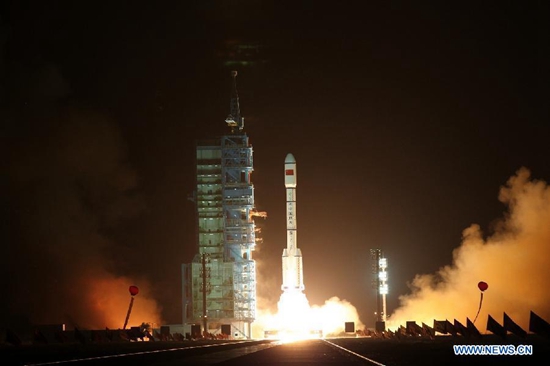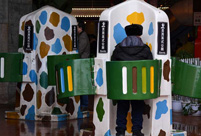

 |
| Xinhua file photo |
BEIJING, Feb. 28 -- China will send its second orbiting space lab Tiangong-2 into space in the third quarter of this year, which is expected to dock with a cargo ship scheduled to be launched in the first half of next year, sources from the manned space program said Sunday.
As part of the country's space lab program, China also plans to launch the Shenzhou-11 spacecraft, which will carry two astronauts on board, in the fourth quarter of this year to dock with Tiangong-2, according to the program's spokesperson.
After its first test flight in the Wenchang satellite launch center in south China's Hainan Province, a next-generation Long March-7 rocket will put the country's first cargo ship Tianzhou-1, which literally means "heavenly vessel," into space in the first half of 2017 to dock with Tiangong-2 and conduct experiments.
During the process, China will verify key technologies including cargo transportation, on-orbit propellant resupply, astronauts' medium-term stay, as well as conduct space science and application experiments on a relatively large scale, the spokesperson said.
Preparation for the space lab program is progressing steadily, according to the spokesperson.
The astronauts to board the Shenzhou-11 are receiving training, while the Tiangong-2, Shenzhou-11, two Long March-2F carrier rockets to be used to lift them into space, the Long March-7 rocket, and the Tianzhou-1 are either being assembled or undergoing assembly examination.
China's multi-billion-dollar space program, a source of surging national pride in the country, aims to put a permanent manned space station into service around 2022.
By around 2020, the construction of the country's first orbiting space station should be completed, according to the spokesperson.
The space station is expected to consist of three parts -- a core module attached to two labs, each weighing about 20 tonnes.
China already launched its first space lab, Tiangong-1, in September 2011 and has conducted two dockings with the module in the following two years.
The Tiangong-1 has been in service for four years and a half and is in good working condition, which enables it to remain in orbit for continued operation, the spokesperson said.
 Engineer troop builds bridge in real combat conditions
Engineer troop builds bridge in real combat conditions You can urinate in public in Chongqing
You can urinate in public in Chongqing Rice terrace scenery in southwest China's Yunnan
Rice terrace scenery in southwest China's Yunnan 2016 Miss Chinatown USA pageant held in San Francisco
2016 Miss Chinatown USA pageant held in San Francisco Ancient pagodas across China
Ancient pagodas across China Wedding dress show up in the air
Wedding dress show up in the air Candidates perform in 2nd examination at Beijing Film Academy
Candidates perform in 2nd examination at Beijing Film Academy Russian photographer brings fairytales to life
Russian photographer brings fairytales to life Chinese beauties, foreign models meet in Chengdu
Chinese beauties, foreign models meet in Chengdu Top 20 hottest women in the world in 2014
Top 20 hottest women in the world in 2014 Top 10 hardest languages to learn
Top 10 hardest languages to learn 10 Chinese female stars with most beautiful faces
10 Chinese female stars with most beautiful faces China’s Top 10 Unique Bridges, Highways and Roads
China’s Top 10 Unique Bridges, Highways and Roads Harsher sanctions on NK are inevitable
Harsher sanctions on NK are inevitable Under Pope Francis and President Xi, hopes rise for a thaw in ties
Under Pope Francis and President Xi, hopes rise for a thaw in ties Why top students from African nations are flocking to Chinese vocational schools
Why top students from African nations are flocking to Chinese vocational schools After recent discovery ‘predicted’ by amateur, demands spread online for scientist to apologize
After recent discovery ‘predicted’ by amateur, demands spread online for scientist to apologizeDay|Week